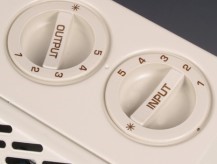5 tips for keeping your Edinburgh home warm this winter

The New Year may be upon us, but that doesn’t mean we’re ready to say goodbye to the cold winter weather. Our Projects Coordinator, Aisling O’Reilly, talks us through 5 easy ways to ensure your home stays warm this winter.
Winter is a carbon-intensive time of year in Scotland, with a need to keep buildings heated and the lights on. We should all try to reduce this demand by being more energy conscious in our homes. Whether you live in a modern house or tenement apartment, there are lots of ways to save energy and keep warm.
Step 1: Reduce drafts
Even if your room is heated to the max, a cold draft running by your feet or shoulders will make you feel cold! So try to eliminate them.
Here are my top tips:
- Get draft excluders for the base of doors
- Close over the blinds and curtains when darkness falls to keep heat in
- Get a rug for flooring without carpeting
- Ask your landlord if you’re renting for other ways they can draft proof your home
Step 2: Don’t block radiators
A lot of home furnishings and décor, although they look nice, can prevent heat from getting into the room. Some of the worst culprits are radiator covers, sofas and desks. If you can, pull the furniture out and away from the radiators, even just a bit, to let warm air circulate in the room.
Step 3: Switch energy providers
Please note: It is not currently advised to switch energy suppliers due to fluctuations in gas prices (February 2022)
If you privately rent, you have control over your energy bills. So if you haven’t done so already, you should switch to one of the UK’s renewable-based energy providers. It’s a great way to reduce your carbon footprint and support a growing green industry.
Look for green plans with the Citizens Advice energy comparison service
Step 4: Know your heating controls
Understanding how your heating system works is the best way to save energy and carbon in your home. If you rent a home in Scotland, it’s likely that your heating system is either a gas boiler or electric heaters. These operate and are controlled in different ways.
Find out how your home gets heated below:
Getting your heating from gas
A boiler uses energy from gas to heat water that then circulates around a system of radiators. Gas boilers tend to be powerful and can heat your home up quickly, provided you’re using the system properly. Here are some things to note:
Get the timings right
It’s important that you set your boiler to come on and off when you need it. There’s no point keeping your home warm when no one is there. I recommend setting your heating to come on a half hour before you get up in the morning and turn off half an hour before you leave the house.
Find your ideal temperature
It’s recommended that you set the temperature of your home to something between 18 and 21oC. There are two things to note here, every degree you turn your thermostat up will cost you an extra £80 a year. Also, if you’re the sort to get home and ramp up the thermostat temperature to the max, please don’t, just because you set a higher temperature it doesn’t mean your home will warm up any quicker.
Radiator controls
TRVs, or thermostatic radiator valves, are another way of controlling your heating system. Most TRVs will have a frost setting (*) and numbers 1 – 3. The frost setting is usually used when no one is in the house. It essentially turns the radiator off but prevents frost build up on the coldest of days. As for the other TRVs, I recommend playing around with these. Usually, you’d want the TRVs set to high or 3, in the room you spend the most time in or sitting still in (as that’s usually when you feel cold). Rooms with heat in them already, like kitchens can probably be set at 1 or 2. For bedrooms, if you’re comfortable in bed under the duvet at night, you can probably afford to set the TRV at 1 or 2 as well.
And the lucky/unlucky few
Some of you will be unfortunate enough to live in a home with no heating controls at all and will have to rely on the “on/off” switch on the boiler. This is how energy is wasted, as it’s easy to forget to turn the heating off when you don’t need it. So, you’ll need to be careful to keep an eye on how long the boiler is kept on.
On the other hand, some of you may be lucky enough to have smart heating controls linked to an app. Smart controls make it easy to keep on top of your energy use. Features allow you to control heating from your phone or switch the heating on when it detects that you’re on your way home. There’s plenty of advice on how to use these apps online.
Getting your heating from electricity
For those of you who get your heat from electricity, there are generally two types of radiators you’ll come across.
Direct-acting electric heaters
These heaters are as simple as you can get and the main controls you’ll see are an “on/off” switch on the radiator or wall, some sort of temperature control and maybe a timer to turn the radiator off after an hour or two. These are simple to use but expensive to run. That’s because they rely on electricity, which is the most expensive heating fuel. It costs around 14p per unit, compared to gas, which costs around 3p. On the upside, electric heating will become greener and greener as the national grid decarbonises.
Electric Storage Heaters
Storage heaters are generally larger and sit closer to the ground, due to the clay brick inside them, which stores heat. Storage heaters work in a different way to direct heaters, in that they “charge up” overnight using a cheaper rate of electricity and slowly release that stored heat during the day. This is a clever way to save money, it also takes pressure off the grid, by using electricity when it’s not in high demand by everyone else. However, a lot of people have trouble with these heaters and find that the stored heat runs out by the time the evening comes around. There are ways to prevent this.
The best way is to control them well. The first control to know about is the “input dial” which usually goes from 1-5. This controls how much electricity you take in, so I’d set this to the max. The “output” dial also ranges from 1-5. This controls how fast you want to release the absorbed heat. So if you set it at 5, all your heat will disappear quickly. I recommend putting it at the lowest setting, then cranking it up higher once you arrive home in the evening.

Storage heater controls showing the input and output dials.
Step 5: Watch out for condensation and mould!
In winter, the cold weather can bring out issues such as water droplets forming on window panes and patches of mould on the walls or ceiling. A cause of this is warm moist air, cooling and condensing on cold surfaces such as windows and walls. However, this build-up can be prevented by reducing the amount of moisture produced inside in the first place.
Here are a few tips:
- Open the windows for a few minutes every day to let moisture out
- If you’re using a clothes rail to dry laundry, place it in a well-ventilated room, or near a window that can be opened from time to time
- Use your kitchen and bathroom extractor fans. Or open the window for 5-10 minutes after cooking or showering.
- Cook with lids on your saucepans
So that’s it. Hopefully, these tips will help tide you over until Spring when the sun finally returns!
Find out more:





Very helpful, thank you.
I would add good insulation – double-glazed windows, insulating layers in floors, walls and ceilings, etc. Though I guess this requires a bit more financial outlay (for homeowners and landlords). 🙂